Forex
Dollar sees first yearly loss since 2020
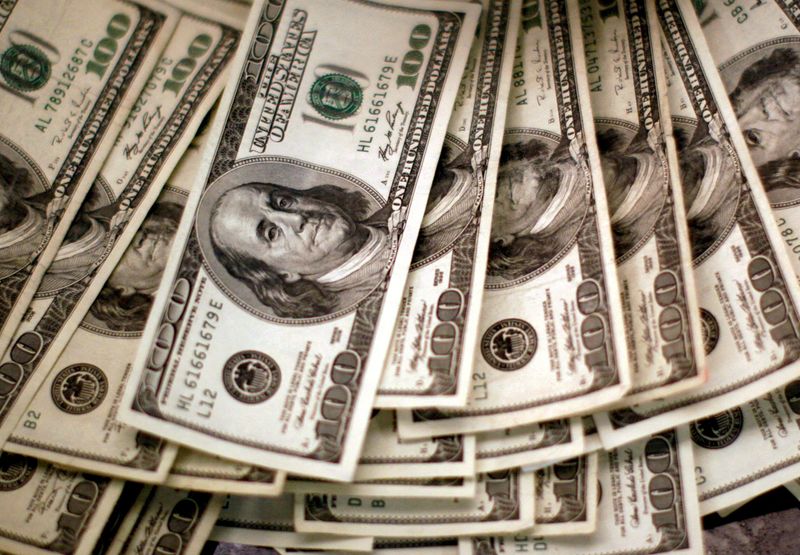
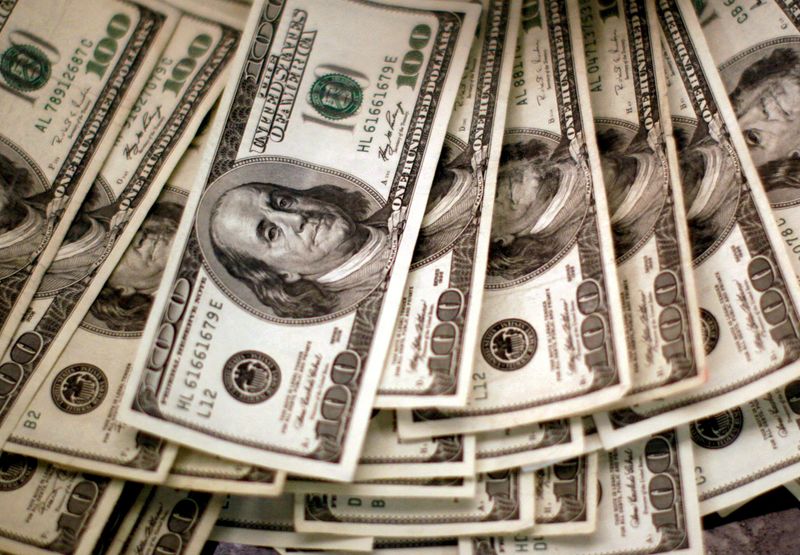
© Reuters. FILE PHOTO: Four thousand U.S. dollars are counted out by a banker counting currency at a bank in Westminster, Colorado November 3, 2009. REUTERS/Rick Wilking/File Photo
By Karen Brettell and Samuel Indyk
NEW YORK/LONDON (Reuters) -The dollar edger higher on Friday but is set to end 2023 with its first yearly loss since 2020 against the euro and a basket of currencies, on expectations the U.S. Federal Reserve will begin cutting rates next year as inflation moderates.
Questions for 2024 will be when the Fed begins cuts, and whether the first rate reduction is made to avoid over-tightening as inflation drops, or due to slowing U.S. economic growth.
With markets already pricing in aggressive cuts, debate is also focused on how much further the dollar is likely to fall.
“We’ve already weakened quite a bit in anticipation of a Fed cut cycle to come,” said Brad Bechtel, global head of FX at Jefferies in New York.
The dollar’s decline accelerated after the Fed adopted an unexpectedly dovish tone and forecast 75 basis points in rate reductions for 2024 at its December policy meeting.
Markets are pricing in even more aggressive cuts, with the first reduction seen likely in March and 158 basis points in cuts expected by year-end.
The Fed’s tone contrasted with other major central banks, including the European Central Bank (ECB) and Bank of England (BoE), which maintained they will hold rates higher for longer.
But “I do think they will capitulate. European growth is just struggling too much and inflation’s coming down relatively fast … same in the U.K. in many ways,” said Bechtel. “If all three central banks are cutting, it’s going to be very hard for the dollar to weaken significantly.”
Against a basket of currencies, the greenback on Friday gained 0.13% to 101.32, rising from a five-month trough of 100.61 reached on Thursday. It is on track to lose 2.10% this year and is down 4.62% this quarter, the worst performance in a year.
The euro dipped 0.19% to $1.1040, hovering just below a five-month peak of $1.11395 reached on Thursday. It is heading for a 3.04% gain for the year, its first positive year since 2020.
“Markets are looking for a cut earlier in the U.S. and are less certain that the European Central Bank will cut as quickly, so that’s why the dollar is very soft,” said Niels Christensen, chief analyst at Nordea.
“We also have positive risk appetite which is another negative for the dollar. Going into 2024, the soft dollar will be a theme towards the March central bank meetings,” Christensen added.
Policymakers at the ECB and the BoE did not signal any imminent rate cuts at their policy meetings this month, but traders are pricing in 162 bps of cuts by the ECB next year, with the probability of two cuts by April. The BoE is also expected to cut rates by 148 bps in 2024.
“While it feels like the market might have moved too far too fast, the facts are that growth is non-existent in Europe, slowing in the U.S., and inflation is falling globally,” said CJ Cowan, portfolio manager at Quilter Investors.
“The ECB is famously slow to change policy course so almost two cuts priced by April looks aggressive, even if it might be the right thing to do.”
Sterling rose 0.08% to $1.2745 and was on track for a 5.39% yearly gain, its best performance since 2017.
YEN IS AN OUTLIER
The dollar is expected to post an annual 7.56% gain against the yen as the Japanese currency stays under pressure from the Bank of Japan’s (BOJ) ultra-loose monetary policy stance.
Market expectations are for the BOJ to exit negative interest rates in 2024, though the central bank continues to stand by its dovish line and has provided little clues on if, and how, such a scenario could play out.
“The outlook for Japan is encouraging going into 2024, with expectations of robust economic growth and improving inflation that shows signs of being sustainable,” said Aadish Kumar, international economist at T. Rowe Price.
That said, even if the BOJ hikes rates into positive territory, they will still remain much lower than in the United States.
“For all of 2024, if they got to positive 50 basis points I would be kind of surprised, but maybe that happens, and if the Fed gives us three rate cuts, you’re still looking at an interest rate differential of roughly 4.5% or so, which makes the yen very expensive to own,” said Jefferies’ Bechtel.
The yen is a popular funding currency, and investors use proceeds from shorting the yen to purchase other assets.
The Swiss franc is one of the best performing currencies this year, with the greenback losing 8.99% against the currency, the worst drop since 2010.
In cryptocurrencies, fell 1.23% to $42,059. It is on track for a 154% gain this year.
========================================================
Currency bid prices at 3:00PM (2000 GMT)
Description RIC Last U.S. Close Pct Change YTD Pct High Bid Low Bid
Previous Change
Session
Dollar index 101.3200 101.2000 +0.13% -2.097% +101.4200 +101.0600
Euro/Dollar $1.1040 $1.1062 -0.19% +3.04% +$1.1084 +$1.1039
Dollar/Yen 141.0200 141.4050 -0.27% +7.56% +141.9100 +140.8000
Euro/Yen 155.69 156.43 -0.47% +10.97% +156.9200 +155.6600
Dollar/Swiss 0.8413 0.8448 -0.38% -8.99% +0.8446 +0.8357
Sterling/Dollar $1.2745 $1.2735 +0.08% +5.39% +$1.2772 +$1.2702
Dollar/Canadian 1.3238 1.3229 +0.08% -2.28% +1.3265 +1.3179
Aussie/Dollar $0.6814 $0.6829 -0.22% -0.04% +$0.6846 +$0.6782
Euro/Swiss 0.9289 0.9342 -0.57% -6.12% +0.9347 +0.9255
Euro/Sterling 0.8660 0.8686 -0.30% -2.08% +0.8701 +0.8661
NZ $0.6320 $0.6333 -0.19% -0.46% +$0.6359 +$0.6306
Dollar/Dollar
Dollar/Norway 10.1520 10.2060 -0.80% +3.16% +10.1990 +10.1100
Euro/Norway 11.2128 11.2800 -0.60% +6.85% +11.2899 +11.1831
Dollar/Sweden 10.0873 9.9876 +0.79% -3.08% +10.0887 +9.9688
Euro/Sweden 11.1353 11.0484 +0.79% -0.13% +11.1390 +11.0395
Forex
UBS maintains RBA rate cut forecast, weighs in on AUD/USD
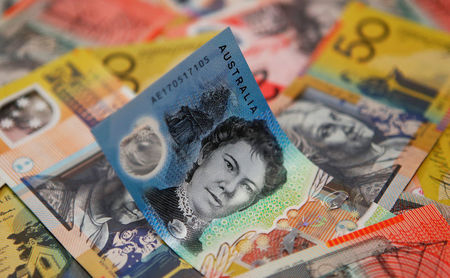
On Thursday, UBS provided insights into the Australian Federal Treasurer Jim Chalmers’ third budget announcement, which reported a second consecutive surplus of AUD 9.3 billion.
Despite this positive outcome, UBS highlighted a projected deficit of AUD 28.3 billion for the fiscal year 2024-25, a figure that is wider than the Treasury’s earlier forecasts.
The firm pointed out that the deficit projection for 2024-25 might be based on overly conservative commodity price assumptions.
UBS suggests that commodity prices are likely to remain higher than anticipated, which could lead to upward fiscal revisions in the future. This outlook is based on details found in the footnotes of the budget document.
In light of the budget details, UBS confirmed that their expectations for the Reserve Bank of Australia’s (RBA) monetary policy remain unchanged. They continue to forecast a 25 basis points cut in the cash rate in February 2025.
Moreover, UBS anticipates that the Australian dollar will maintain its higher trading range against the US dollar, fluctuating between 0.65 and 0.675.
The budget surplus achieved this year contrasts with the anticipated deficit for the next fiscal year. This shift reflects the dynamic nature of Australia’s economic landscape and the challenges that may arise in the medium term. UBS’s analysis suggests that the budget’s implications have been thoroughly considered and have not altered their long-term economic forecasts for Australia.
UBS’s commentary provides a focused perspective on the fiscal situation in Australia, without implying broader economic trends or industry-wide impacts. The firm’s projections are specific to their analysis of commodity prices and the anticipated actions of the RBA, taking into account the latest federal budget details.
remove ads
.
This article was generated with the support of AI and reviewed by an editor. For more information see our T&C.
Forex
Dollar stabilizes after sharp CPI-induced fall; euro hands back some gains
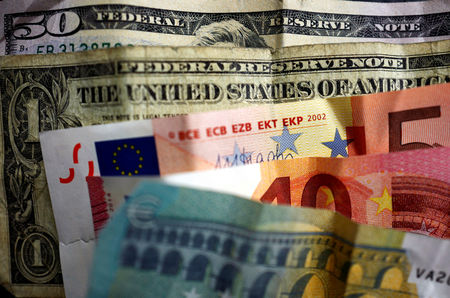
Investing.com – The U.S. dollar steadied in European trade Thursday, after dropping to multi-week lows overnight in the wake of a milder U.S. inflation report, which brought Fed rate cuts back into focus.
At 04:25 ET (08:25 GMT), the Dollar Index, which tracks the greenback against a basket of six other currencies, traded 0.1% higher at 104.285, having fallen to a five-week low just below 104 overnight.
Dollar on back foot after key inflation data
The dollar remains on the back foot after the latest U.S. inflation data raised expectations the will deliver two interest rate cuts this year, probably starting in September.
Wednesday’s rose by 0.3% in April, below an expected 0.4% gain, which came as a relief to markets after sticky consumer prices in the first quarter had led to a sharp paring of rate cut bets and even stoked some worries of an additional hike.
The data also resulted in U.S. Treasury yields sinking to six-week troughs, as traders reassessed the likely path of the Fed’s monetary policy.
“Markets have given a greater weight to the encouraging news coming from two days of inflation figures, which has caused the dollar to almost entirely erase the gains after the CPI disappointment in mid-April,” said analysts at ING, in a note.
There are a number of Fed speakers due to opine later in the session, but it’s likely investors will need concrete evidence if rate cut expectations are to be changed drastically from now.
remove ads
.
“Our preferred call at this stage is not for a continuation of a dollar decline until the end of May, but instead a period of quiet trading with little sense of direction and low volatility. That’s mainly because hard data is needed to move the needle substantially on Fed pricing, and the next key release – core PCE – is only on 31 May,” ING added.
Euro retreats from earlier highs
In Europe, traded 0.1% lower to 1.0867, with the euro retreating slightly Thursday after earlier climbing to its highest since March 21.
The is widely expected to start cutting interest rates from a record high in June, and markets now see up to three rate cuts this year, or two beyond June, most likely in September and December.
“The 1.0900 level should not be a very strong resistance if U.S. data – for example, jobless claims today – adds pressure on the dollar. However, a move to the 1.1000 benchmark levels seems premature given the still sticky inflation picture in the U.S.,” ING said.
fell 0.1% to 1.2675, with sterling handing back some of the previous session’s gains when it climbed above 1.27 for the first time since April 10.
The is also expected to cut rates from a 16-year high this summer, but recent stronger than expected GDP growth could delay this until after the ECB moves.
Yen posts minor gains after weak GDP data
In Asia, fell 0.2% to 154.64, with the yen benefiting from the dollar’s weakness, but the pair remained well above levels hit earlier in May, when the government was seen intervening in currency markets.
remove ads
.
The yen’s recovery stalled as data showed the Japanese economy shrank much more than expected in the first quarter, raising doubts over just how much headroom the Bank of Japan has to keep raising interest rates.
traded largely flat at 7.2187, as sentiment towards China remains weak after Washington imposed stricter trade tariffs on China’s key industries, such as electric vehicles, medicines and solar technology.
Forex
Yen climbs while dollar stabilises after US inflation ebbs
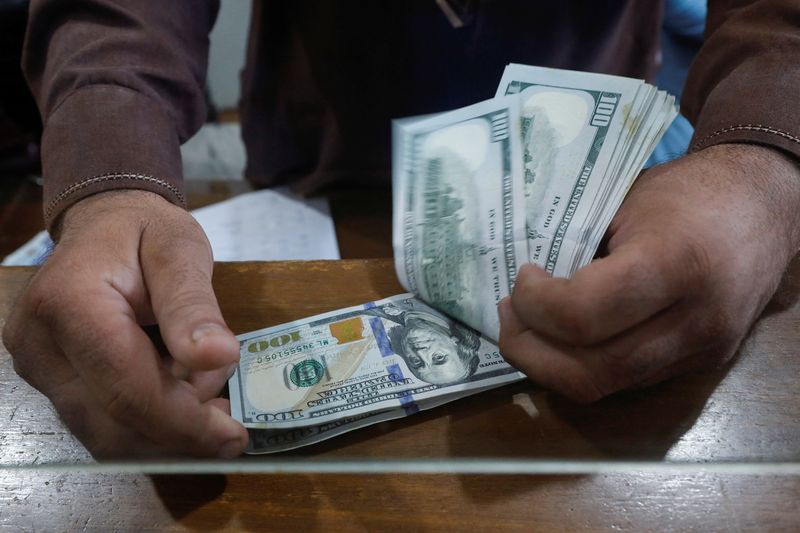
By Harry Robertson and Tom Westbrook
LONDON/SINGAPORE (Reuters) – The Japanese yen rallied for a second day on Thursday after data on Wednesday showed a slowdown in U.S. inflation, while the dollar found a footing against other currencies following a sharp drop the previous day.
U.S. inflation slowed to 0.3% in April from a month earlier, down from 0.4% in March and below expectations for another 0.4% reading, Wednesday’s data showed.
Year-on-year core inflation – which strips out volatile food and energy prices – fell to its lowest in three years at 3.6%. Meanwhile, retail sales were flat, suggesting conditions for Federal Reserve interest rate cuts are falling into place.
The dollar dropped 1% against the yen on Wednesday after the data and was down a further 0.38% on Thursday at 154.32, having fallen as low as 153.6 before weak Japanese growth figures took some of the shine off the yen.
The Japanese currency has fallen around 9.5% this year as the Bank of Japan has kept monetary policy loose while higher Fed interest rates have drawn money towards U.S. bonds and the dollar. The yen has been particularly sensitive to any widening or closing of the interest rate differential.
The , which tracks the currency against six major peers, was last up 0.11% at 104.32 on Thursday after falling 0.75% on Wednesday as investors raise their bets on Fed rate cuts, now envisaging two reductions by the end of the year.
Some analysts said Fed officials will want to see proof of inflation’s downward path before countenancing cuts, a point made by Minneapolis Fed President Neel Kashkari on Wednesday.
remove ads
.
Francesco Pesole, FX strategist at ING, said: “In practice there isn’t all that much to be all that optimistic about. Inflation is moving in the right direction but still not at levels that would allow the Fed to cut rates.”
Pesole said investors were now waiting for U.S. personal consumption expenditures inflation data in late May. “My view at this stage is that we could just default to another couple of weeks of low volatility, lack of direction, and range-bound trading.”
The euro hit a two-month high at $1.0895 on Thursday before dipping to trade 0.1% lower at $1.0874. Britain’s pound reached a one-month top of $1.2675 before falling back slightly.
The Australian dollar, which surged 1% on Wednesday, hit a four-month high at $0.6714 but then paused after an unexpected rise in Australian unemployment.
It was last at $0.6684 as traders priced out any risk of a further rate hike in Australia.
touched a three-week high of $66,695 before dipping slightly.

 Forex2 years ago
Forex2 years agoForex Today: the dollar is gaining strength amid gloomy sentiment at the start of the Fed’s week

 Forex2 years ago
Forex2 years agoHow is the Australian dollar doing today?

 Forex1 year ago
Forex1 year agoUnbiased review of Pocket Option broker

 Forex2 years ago
Forex2 years agoDollar to pound sterling exchange rate today: Pound plummeted to its lowest since 1985

 Cryptocurrency2 years ago
Cryptocurrency2 years agoWhat happened in the crypto market – current events today

 World2 years ago
World2 years agoWhy are modern video games an art form?

 Stock Markets2 years ago
Stock Markets2 years agoMorgan Stanley: bear market rally to continue

 Economy2 years ago
Economy2 years agoCrude oil tankers double in price due to EU anti-Russian sanctions

































